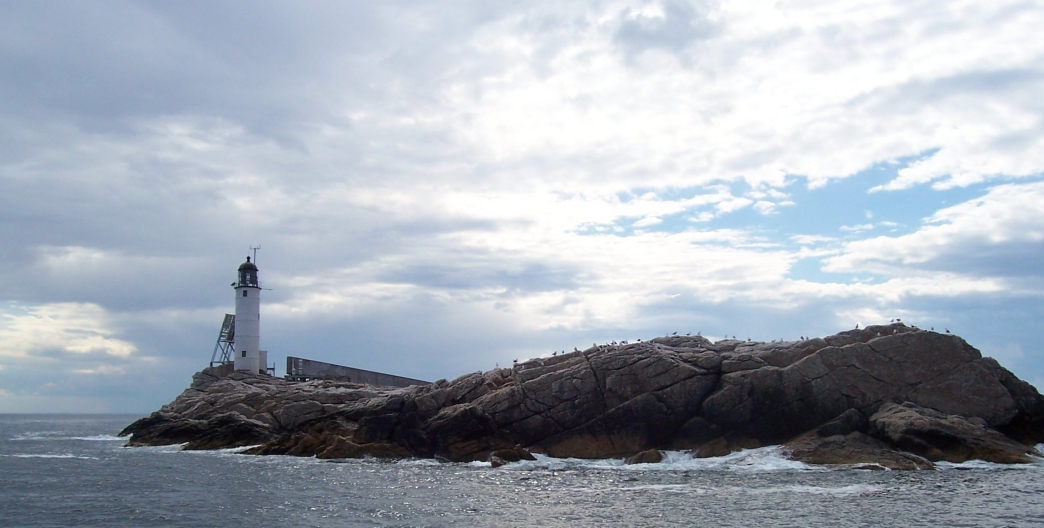Originally written for RootsRated
Straddling the border between Maine and New Hampshire is a set of nine unassuming islands called the Isles of Shoals. Small, isolated, and barely developed these islands are often overlooked by those seeking a coastal New England adventure. However, that just adds to their allure. The islands are about six miles out to sea, though if it’s foggy it’s possible to miss them entirely. Four of the nine islands belong to New Hampshire and five to Maine. In total, the nine islands cover 145 acres–less than a quarter of a square mile.
If you manage to catch a ride on one of the two ferries that make infrequent trips out to the Isles of Shoals–or if you’re daring enough to paddle out to the islands yourself or as part of a guided trip–you may not discover much of immediate interest. Windswept and desolate, the islands have no year-round residents, only a few man-made structures, and little vegetation larger than the plentiful huckleberry and bayberry bushes.
And yet, while seemingly insignificant, the islands are rich in history, with the pedigree of having been “discovered” by Jamestown founder John Smith, honeymooned on by the infamous pirate Blackbeard, and feted by the likes of writer Nathaniel Hawthorne, Supreme Court Justice Oliver Wendell Holmes, and Impressionist painter Childe Hassam.
If you’re craving the crowded beach scenes of Newport,RI, the bustling social scene of Cape Cod, or the refined comfort of Kennebunkport, ME then check these islands off your list. But if you would like to experience a day or weekend in a place that helped shape New England into what it is today, it doesn’t get any more authentic than the Isles of Shoals.
Small Islands, Big History

Archeological evidence found on the Isles of Shoals suggests a Native American presence dating back more than 5,000 years. But the first European who set foot on the islands was John Smith in 1614 during his first voyage back to the New World after he helped found the Jamestown colony. In the 1600s, hundreds of English fishermen made the islands their home, for a time catching enough fish to rival Boston for sheer volume of total exported tonnage. At its height in the 1700s, the island’s population was as large as 1,800.
In contrast to the severe, disciplined Puritan communities on the mainland, the islands developed a reputation for their frontier-like rowdiness. Perhaps it was that reputation that drew the notorious pirate Blackbeard to the islands around 1720, his new wife (thought to be his fifteenth) in tow. However, the honeymoon was cut short when Blackbeard fled after sighting British warships.He left his bride–and rumors of buried treasure–behind. Blackbeard’s legacy remains: four bars of what was presumed to be Blackbeard’s silver were found under a rock on Smuttynose Island by a resident in 1820 and were used to pay for a breakwater still in existence today. And according to lore, the ghost of Blackbeard’s wife still wanders the island repeating the words, "He will come again."
In the 1800s, the islands slowly lost population, precipitated by Massachusetts’ annexation of Maine and its subsequent efforts to tax the islanders. In 1813, the Spanish ship Sagunto wrecked on the nearby shoals and only one sailor survived. Further tragedy hit the islands in 1873, when two girls were murdered, which thrust the islands into national news at the time. The events were recently written about in the national bestseller, “The Weight of Water,” which subsequently became a movie directed by Kathryn Bigelow and starring Sean Penn and Elizabeth Hurley.
“The Weight of Water” is hardly the only piece of writing to have its origins in the Isles of Shoals. Celia Thaxter, the daughter of the owner of a (now closed) hotel on the island, became one of the most popular American poets of the 19th century. Her hotel, the Appledore House, became one of America’s first “salons,” a center of the young country’s nascent cultural scene, receiving frequent visits from Hawthorne, Wendell Holmes, Hassam, the poet and abolitionist John Greenleaf Whittier, novelist Sarah Orne Jewett, and painter William Morris Hunt, who drowned off the Isles in a suicide in 1879.
While the islands’ heyday as an artists’ retreat has past, they are still inspiring creativity of all sorts– Smuttynose Island gave its name to the eponymous microbrewery, located in Hampton, N.H., which has been producing palette-pleasing beers for two decades.
Getting There and What to Do

All of the Isles of Shoals are privately owned and so arranging the details of a visit is an adventure in itself. Portsmouth, N.H.-based Isle of Shoals Steamship Company and Rye, N.H.-based Island Cruises operate the only regular ferry services to Star Island. It’s also possible to charter a motorboat or sailboat and moor near the islands and then come ashore via dinghy.
The ferry and charter companies offer half- and full-day tours, but if you want to get the true experience of the islands, reserve a room at the Oceanic House on Star Island. It was built more than 100 years ago and is infused with charm. The hotel is affiliated with the United Church of Christ and throughout the summer, it hosts activities and conferences on topics as varied as dance, photography, nature and yoga, all loosely aligned with the Unitarian-Universalist religious movement, though guests are not required to participate. Rooms are simply furnished and generally don’t have private baths.
If you decide to brave the hotel’s rustic conditions you will be able to explore the islands the way they were meant to be enjoyed: without hurry. On Star Island, the Gosport Chapel is more than 150 years old, and the small cemetery nearby is even older. If you continue on past a few other 18th-century wooden cottages you'll find a monument to Captain John Smith, built in 1864 to commemorate the 250th anniversary of his visit.

InAweofGod’sCreation
You can also paddle over to White Island and visit the lighthouse there, built in 1859. You can then continue on past Smuttynose Island, the location of the Haley House, the oldest house in Maine, to Appledore Island, the home of the Shoals Marine Laboratory , a cooperative between Cornell and the University of New Hampshire. Duck Island is also worth checking out, as it’s preserved as a wildlife sanctuary by the Maine Coastal Heritage Trust. It’s home to snowy egrets, cormorants and plenty of seagulls. Keep an eye peeled for the local seal colony and the occasional whale spout offshore. Upon your return to Star Island, if you’ve got a fishing pole, toss a few casts around the boats in Gosport Harbor, a favorite hang-out for large striped bass.
About 9,000 people visited the Isles of Shoals last summer, but only a fraction stayed overnight. Once the day-trippers board the ferry and depart for the mainland, the islands undergo a transformation. You’ll find yourself in a sudden, quiet calm. You’ll experience the joy and wonder of having the islands to yourself, the simple comfort of home-cooked meals served family-style, and, in the morning, the incomparable peacefulness of a hot cup of coffee enjoyed in a rocking chair overlooking the open ocean. You’ll realize those who perceive the islands as empty and bleak are missing what many of the islands’ previous residents have seen: they are a blank canvas, waiting for your imagination to begin sketching.
Featured image provided by InAweofGod’sCreation

